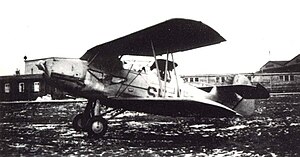| Ar 66 | |
|---|---|
 | |
| General information | |
| Type | Trainer |
| Manufacturer | Arado Flugzeugwerke |
| Designer | |
| Primary user | Luftwaffe |
| Number built | 1,456 |
| History | |
| Introduction date | 1933 |
| First flight | 1932[1] |


The Arado Ar 66 was a single-engined twin-seat training biplane designed and produced by the German aircraft manufacturer Arado. It was the last aircraft to be designed by the aeronautical engineer Walter Rethel in collaboration with Arado.[1]
The Ar 66 was developed as a military trainer aircraft during the early 1930s. First flown in 1932, it quickly proved superior to two rival aircraft and was selected to meet the training needs of the Luftwaffe. In addition to primary flight training, the Ar 66 was used for aerobatics and night-time instruction along with the training of various air crew positions, such as bombardiers, radio operations, aerial photographers, and machine gun operators.
The Ar 66 was produced by multiple companies under licence in order to provide the large numbers sought. In addition to the Luftwaffe, which introduced the type in 1933, both the Czechoslovakian Air Force and Spanish Air Force also operated a number of Ar 66s. In addition to land-based use, it could also be deployed as a float plane. The Ar 66 remained in use throughout the Second World War. Additionally, it was deployed by the Luftwaffe into front line combat during the conflict; Ar 66s regularly undertook night ground-attack missions on the Eastern Front.